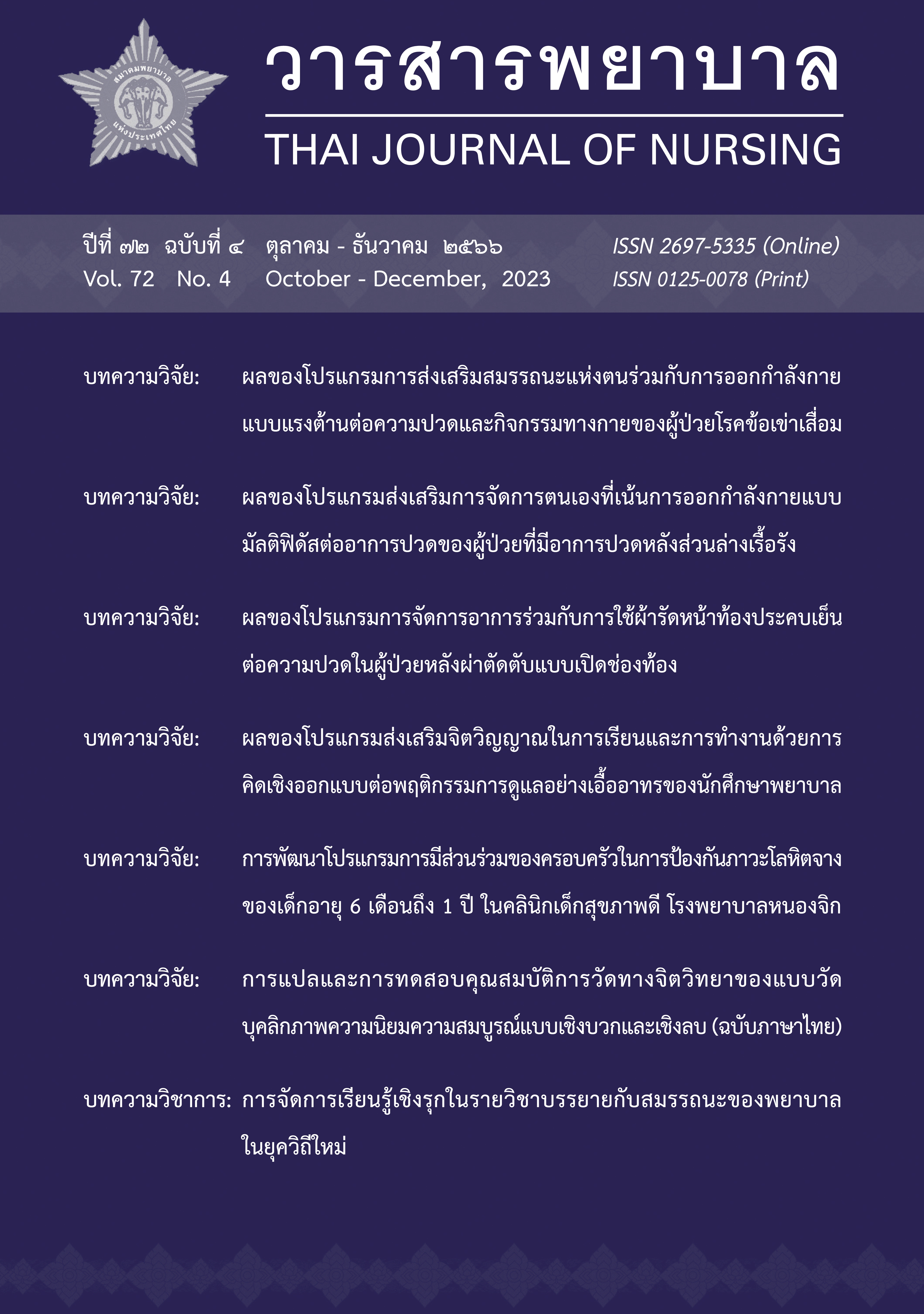การพัฒนาโปรแกรมการมีส่วนร่วมของครอบครัวในการป้องกันภาวะโลหิตจางของเด็ก อายุ 6 เดือนถึง 1 ปี ในคลินิกเด็กสุขภาพดี โรงพยาบาลหนองจิก
Main Article Content
บทคัดย่อ
การวิจัยและพัฒนานี้มีวัตถุประสงค์เพื่อพัฒนาโปรแกรมการมีส่วนร่วมของครอบครัวในการป้องกันภาวะโลหิตจางของเด็กอายุ 6 เดือนถึง 1 ปี ในคลินิกเด็กสุขภาพดี โรงพยาบาลหนองจิก การวิจัยนี้ใช้รูปแบบการส่งเสริมสุขภาพของเพนเดอร์เป็นกรอบแนวคิดของการวิจัย การพัฒนาโปรแกรมแบ่งเป็น 3 ระยะ ระยะที่ 1 ศึกษาการมีส่วนร่วมครอบครัว ระยะที่ 2 พัฒนาโปรแกรมการมีส่วนร่วมของครอบครัว และระยะที่ 3 นำโปรแกรมการมีส่วนร่วมของครอบครัวไปใช้และปรับปรุงคุณภาพ กลุ่มตัวอย่าง จำนวน 20 คน เลือกแบบเจาะจงโดยเป็นครอบครัวที่มีผู้ดูแลเด็กอายุ 6 เดือนถึง 1 ปี เก็บรวบ รวมข้อมูลโดยใช้แบบสอบถามข้อมูลส่วนบุคคล แบบทดสอบความรู้ และแบบสัมภาษณ์กึ่งโครงสร้างใช้ในการสนทนากลุ่ม วิเคราะห์ข้อมูลใช้สถิติพรรณนาและการวิเคราะห์เนื้อหา ผลการวิจัย พบว่า โปรแกรมที่พัฒนาขึ้นประกอบด้วย 3 ขั้นตอน ได้แก่ การประเมินสภาพทั่วไปครอบครัว การวางแผนและการปฏิบัติ และการประเมินติดตามเยี่ยมบ้าน เมื่อพยาบาล 3 คนได้นำโปรแกรมไปใช้กับมารดาและเด็ก จำนวน 10 คน พบว่า มีเด็กที่มีภาวะซีดมาก จำนวน 1 คน (10%) และร้อยละ 90 ของมารดาเป็นผู้ดูแลเด็กและมีอิทธิพลในการตัดสินใจ ร้อยละ 80 ของผู้ดูแลมีความรู้ภาวะโลหิตจางจากการขาดธาตุเหล็ก อาหารตามวัย และยาเสริมธาตุเหล็กอยู่ในระดับดี
Article Details

อนุญาตภายใต้เงื่อนไข Creative Commons Attribution-NonCommercial-NoDerivatives 4.0 International License.
เอกสารอ้างอิง
นภัสวรรณ ชนะพาล. (2565). รูปแบบการดำเนินงานการจัดการภาวะซีดในเด็กนักเรียนระดับประถมศึกษา. วารสารศูนย์อนามัยที่ 9, 16(2), 565-580.
บุษบา อรรถาวีร์ และ บำเพ็ญ พงศ์เพชรดิถ. (2563). การควบคุมและป้องกันภาวะโลหิตจางจากการขาดธาตุเหล็กในเด็กอายุ 6-12 เดือน. วารสารพยาบาลกระทรวงสาธารณสุข, 30(1), 82-93.
ปิยะ ปุริโส, ลัดดา ดีอันกอง, กัญญาภัทร คำโสม, ธิโสภิญ ทองไทย, และ ทัศนีย์ รอดชมภู. (2564). ความชุก และปัจจัยที่มีความสัมพันธ์กับภาวะโลหิตจางจากการขาดธาตุเหล็กในเด็กปฐมวัย (อายุ 6–72 เดือน) เขตสุขภาพ ที่ 7. วารสารการส่งเสริมสุขภาพและอนามัยสิ่งแวดล้อม, 44(2), 39-53.
มนัสวี ภู่พงศ์เพ็ชร. (2565). ความชุกและปัจจัยที่สัมพันธ์กับภาวะโลหิตจางในเด็กไทยอายุ 9 เดือนที่มารับบริการที่คลินิกตรวจสุขภาพเด็กดี โรงพยาบาลตํารวจ. วารสารเวชศาสตร์ครอบครัว, 5(3), 185-194.
ศรัณยา ลาโมะ, สุนันทา ยังวนิชเศรษฐ, และ เบญญาภา ธิติมาพงษ์. (2564). โปรแกรมการส่งเสริมโภชนาการร่วมกับการสนับสนุนจากครอบครัวต่อพฤติกรรมการบริโภคอาหาร ยาเสริมธาตุเหล็ก และความเข้มข้นของเลือดในหญิงตั้งครรภ์วัยรุ่นที่มีภาวะโลหิตจาง. วารสารพยาบาลกระทรวงสาธารณสุข, 31(1), 224-236.
หน้าประชาชื่น:โลหิตจางเพราะขาดธาตุเหล็กส่งผลไอคิวในวัยเรียนต่ำลง 5-10 จุด. (2562, 7 พฤษภาคม). มติชนออนไลน์. https://www.matichon.co.th/prachachuen/prachachuen-scoop/news_1484950
อัญชลี ภูมิจันทึก, ชัชฎา ประจุดทะเก, และ ประดับ ศรีหมื่นไวย. (2562). สถานการณ์และปัจจัยที่มีผลต่อภาวะซีดในเด็กปฐมวัยเขตสุขภาพที่ 9. วารสารศูนย์อนามัยที่ 9, 13(31), 178-190.
Pender, N. J., Murdaugh, C. L., & Parsons, M. A. (2006). Health promotion in nursing practice (5th ed.). Prentice Hall.


